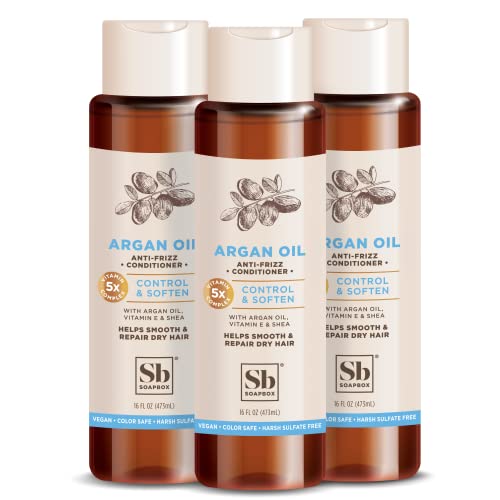
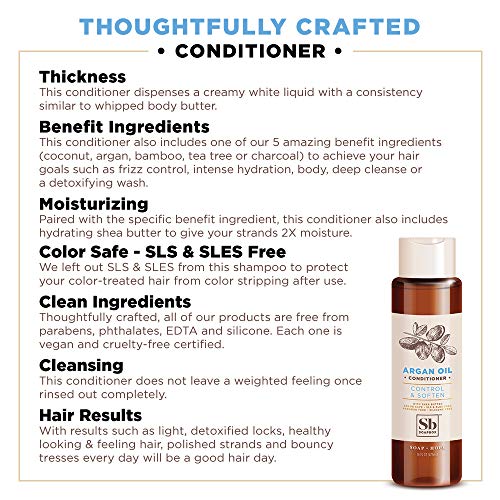
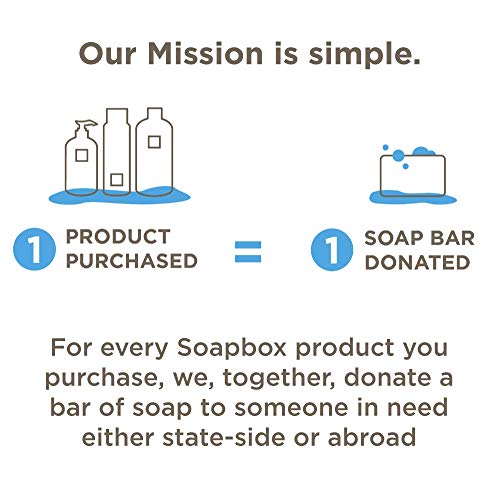
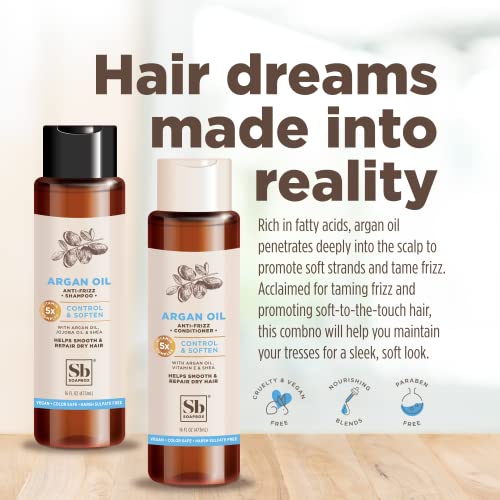
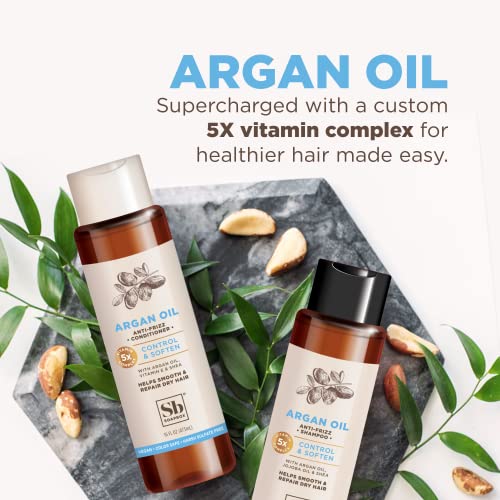
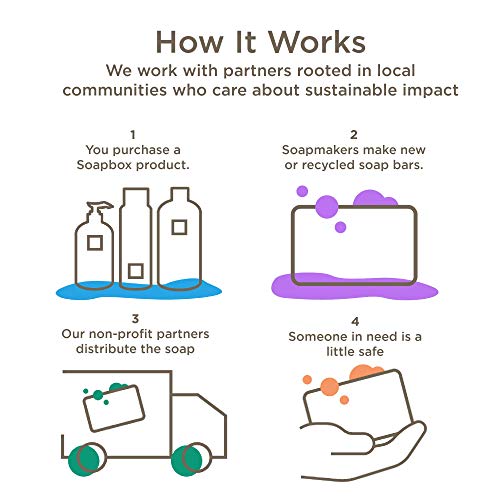
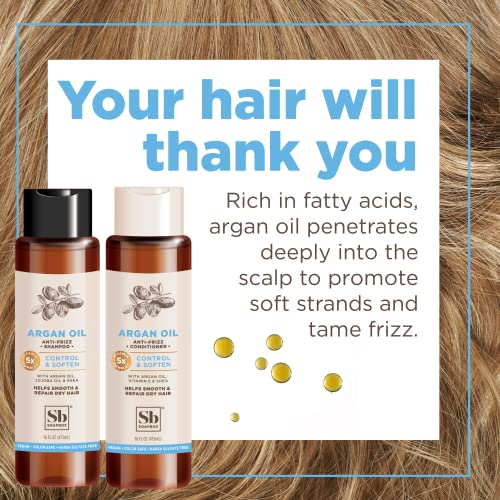
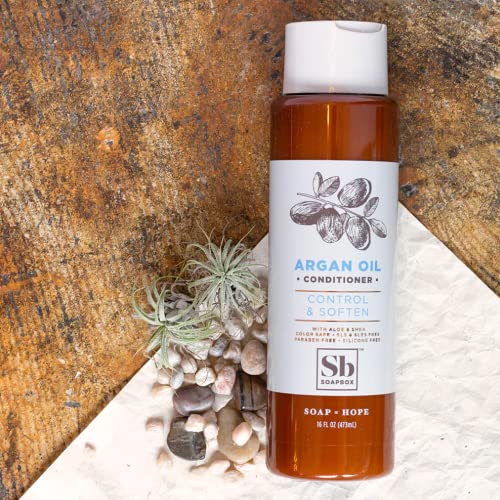
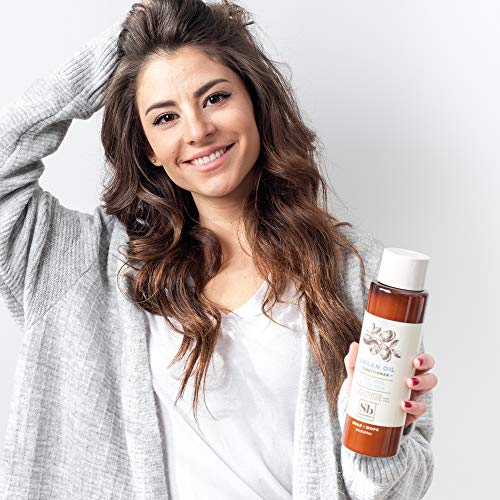
Soapbox Argan Oil & Shea Butter Conditioner - Volumizing, Vegan, Color Safe - 16oz, Pack of 3


Stearalkonium Chloride
High RiskStearalkonium chloride is a quaternary ammonium compound commonly used as a conditioning agent in hair and skin care products. It functions primarily as an emulsifier and surfactant, helping to improve product texture and enhance moisture retention.
Sustai Insights
Stearalkonium chloride offers functional benefits as a conditioning agent and emulsifier. However, it carries a high concern for allergies and immunotoxicity, with restrictions noted in some regulatory frameworks. Potential health risks include skin irritation and respiratory issues, while environmental risks relate to its pollutant potential. Regulatory agencies have raised warnings about its use, leading to an overall high-risk assessment. Users should consider safer alternatives, especially in sensitive applications.
Cetrimonium Chloride
High RiskCetrimonium chloride is a quaternary ammonium compound commonly used in personal care products as a conditioning agent and emulsifier. It aids in improving the texture and manageability of hair and skin, serving as a surfactant that reduces surface tension.
Sustai Insights
Cetrimonium chloride provides functional benefits as an effective conditioning agent, enhancing product performance. However, it poses moderate health risks, including potential allergenic reactions and irritation, while being classified with high usage restrictions by regulatory authorities. Environmental concerns include its status as a pollutant with potential bioaccumulative effects. Overall, the ingredient presents a high risk level, necessitating cautious usage and consideration of safer alternatives.
Benzyl Alcohol
High RiskBenzyl alcohol is a naturally occurring and synthetic aromatic alcohol commonly used as a solvent, preservative, and fragrance ingredient in various products. It is found in both plant sources and as a synthetic compound, functioning primarily to maintain product stability and enhance fragrance profiles.
Sustai Insights
Benzyl alcohol serves effectively as a preservative and solvent, contributing to product stability and sensory qualities. However, it poses potential health risks, particularly as an allergen, with high concern for immunotoxicity. Environmental risks include being a pollutant with low bioaccumulation potential. Regulatory agencies have established restrictions on its use in certain products. Overall, the risk level associated with benzyl alcohol is assessed as high, necessitating careful consideration of its use and potential alternatives.
Behenyl Trimonium Methosulfate
Medium RiskBehentrimonium methosulfate is a quaternary ammonium compound commonly used in personal care products as a conditioning agent. It functions effectively as a surfactant and emulsifier, helping to improve the texture and application of formulations, especially in hair care and skin products.
Sustai Insights
Behentrimonium methosulfate offers functional benefits as a conditioning agent, enhancing product performance in hair and skin applications. It is considered to have low health risks, with minimal concerns for carcinogenicity, allergies, or reproductive toxicity. Environmental risks are also low, with no evidence of bioaccumulation. However, regulatory bodies note some restrictions on its use in verified products. Overall, the ingredient presents a medium risk profile, highlighting the importance of adhering to safe usage practices and considering alternatives when available.
Citric Acid
Medium RiskCitric acid is an alpha hydroxy acid used in personal care products primarily for its role as a pH adjuster and natural preservative. It occurs naturally in citrus fruits and is commonly utilized in various formulations for its chelating properties and mild exfoliation benefits.
Sustai Insights
Citric acid offers functional benefits as an effective preservative and pH stabilizer, contributing to product longevity and stability. It is biodegradable and derived from renewable sources. Health risks are low, with minimal concerns regarding carcinogenicity, allergies, and reproductive toxicity. However, moderate use restrictions exist due to potential irritation at high concentrations. Environmental risks are limited, as citric acid is not known to accumulate in ecosystems. Regulatory agencies have no significant advisories against its use. Overall, it is assessed as a medium-risk ingredient, with safe usage practices recommended and alternatives available.
Polyquaternium 11
Low RiskPolyquaternium-11 is a quaternary ammonium polymer used primarily in cosmetic formulations as a conditioning agent and film-forming agent. It enhances the texture and feel of products, providing moisture retention and improved product stability.
Sustai Insights
Polyquaternium-11 offers functional benefits as a conditioning agent, improving the texture of hair and skin products. It is generally regarded as safe with low concerns for cancer, allergies, and reproductive toxicity. Environmental risks are minimal, as it is not classified as a pollutant or bioaccumulative. Regulatory bodies have not imposed significant restrictions. Safe usage is recommended, and alternatives may include other conditioning agents like hydrolyzed proteins. Overall, the ingredient is assessed as low risk.
Stearyl Alcohol
Low RiskStearyl alcohol is a compound produced from the hydrogenation of stearic acid, commonly used in cosmetic formulations as an emulsifier and thickening agent. It helps stabilize products by blending oil and water phases, enhancing texture and consistency.
Sustai Insights
Stearyl alcohol provides functional benefits as an emulsifier and stabilizer, contributing to improved product texture. It is generally regarded as safe with low concerns for cancer, allergies, and reproductive toxicity. However, it may cause moderate skin, eye, or respiratory irritation. Regulatory bodies do not impose significant restrictions, indicating a low overall risk. While it poses minimal health and environmental hazards, caution is advised for sensitive individuals. Alternatives like cetyl alcohol or plant-based emulsifiers may offer safer options for formulators.
Argania Spinosa (Argan) Kernel Oil
Low RiskArgania spinosa (argan) kernel oil is a fixed oil extracted from the kernels of the argan tree, native to Morocco. It is commonly used in cosmetic formulations for its moisturizing properties, serving as an emollient and skin conditioner.
Sustai Insights
Argania spinosa kernel oil offers functional benefits such as effective hydration and nourishment for the skin and hair. It is sustainably sourced and biodegradable, contributing positively to environmental considerations. Health risks are low, with minimal concerns regarding carcinogenicity, allergies, or reproductive toxicity. There are no current regulatory restrictions on its use. Overall, it poses low risk, making it a suitable ingredient in cosmetic products. Safe usage practices should be maintained, and alternatives like jojoba oil may also be considered for similar benefits.
Guar Hydroxypropyltrimonium Chloride
Low RiskGuar hydroxypropyltrimonium chloride is a quaternary ammonium compound derived from guar gum, primarily used as a conditioning agent in cosmetic products. It enhances the texture and feel of hair and skin formulations, providing moisture retention and improved manageability.
Sustai Insights
This ingredient offers functional benefits as a conditioning agent, improving the texture and moisture retention in formulations. It is considered low risk regarding health effects, with minimal concerns for carcinogenicity, allergies, or reproductive toxicity. Environmental risks are also low, as it does not accumulate significantly in ecosystems. Regulatory bodies have not imposed significant restrictions. Safe usage practices should be followed, but overall, this ingredient is assessed as low risk, with no immediate concerns regarding alternatives.
Panthenol, D
Low RiskPanthenol, also known as provitamin B5, is a humectant commonly used in cosmetic and personal care products. It functions primarily as a moisturizer, enhancing skin hydration and improving the appearance of hair by imparting shine and softness.
Sustai Insights
Panthenol is effective in retaining moisture, thus providing functional benefits for skin and hair care products. It is generally recognized as safe, with low concerns regarding carcinogenicity, allergies, and developmental toxicity. However, potential cumulative exposure from multiple sources exists. Environmental risks are minimal, and it is not bioaccumulative. Regulatory bodies have not issued significant warnings; therefore, the overall risk level is assessed as low. For optimal use, it is recommended to follow product guidelines, and alternatives such as glycerin may also be considered for moisturizing effects.
Cetyl Alcohol
Low RiskCetyl alcohol is a long-chain organic alcohol commonly used in cosmetic formulations. It serves as an emollient, emulsifier, and thickening agent, enhancing the texture and stability of products. Cetyl alcohol is derived from natural sources, such as coconut or palm oil, and is often included in creams, lotions, and hair conditioners.
Sustai Insights
Cetyl alcohol offers functional benefits as an emollient and emulsifier, improving product texture and stability. It is biodegradable and sourced from renewable materials, contributing to sustainability. Health risks are minimal, with low concerns for carcinogenicity, allergies, or reproductive toxicity. Environmental impact is also low, with no significant pollutant or bioaccumulation potential. Regulatory bodies have not placed restrictions on its use, indicating a favorable safety profile. Overall, cetyl alcohol is assessed as low risk, and safe usage practices include ensuring proper formulation concentrations.
Limnanthes Versicolor (Meadowfoam) Seed Oil
Low RiskLimnanthes versicolor (meadowfoam) seed oil is derived from the seeds of the meadowfoam plant. It is commonly used in cosmetic formulations for its emollient properties, providing moisture and improving texture in skin and hair care products.
Sustai Insights
Meadowfoam seed oil offers functional benefits as a moisturizer and skin conditioner, being sustainably sourced and biodegradable. Health risks are minimal, with low concerns for carcinogenicity, allergies, and reproductive toxicity. Environmental risks are also low, with no significant pollutant potential. Current regulatory assessments do not indicate restrictions. Overall, this ingredient poses a low-risk profile, making it a suitable choice in cosmetic formulations.
Water
Low RiskWater is a clear, colorless liquid essential for various biological processes. It serves as a solvent in formulations, facilitating the dissolution of other ingredients and enhancing product texture and application. Additionally, water plays a crucial role in hydration and is a key component in many cosmetic and personal care products.
Sustai Insights
Water is an effective solvent and hydrator, contributing to the texture and efficacy of formulations. It is biodegradable and generally regarded as safe, with low concerns regarding carcinogenicity, allergies, and reproductive toxicity. However, excessive water usage can lead to environmental concerns, particularly regarding resource depletion. Regulatory bodies do not impose restrictions on water use in cosmetics. Overall, the risks associated with water are low, making it a safe and essential ingredient.
Vegetarian Glycerin
Low RiskVegetarian glycerin, also known as glycerol, is a colorless, odorless, and viscous liquid derived from plant sources. It is primarily used as a humectant, solvent, and emollient in various personal care products, helping to retain moisture and improve texture.
Sustai Insights
Vegetarian glycerin offers functional benefits as an effective humectant, promoting hydration and skin smoothness. It is biodegradable and typically sustainably sourced. Health risks associated with glycerin are low, with no significant concerns for carcinogenicity, allergens, or reproductive toxicity. Environmental risks are minimal, and it is not subject to major regulatory warnings. Overall, the risk level for this ingredient is low, making it a safe choice in formulations. Safe usage practices include ensuring proper concentrations in products, and alternatives such as propylene glycol exist but may have differing properties.
Dehydroacetic Acid
Low RiskDehydroacetic acid is a synthetic preservative commonly used in cosmetic and personal care products to inhibit microbial growth and extend shelf life.
Sustai Insights
Dehydroacetic acid offers effective preservation, enhancing product stability. It is considered low risk for carcinogenicity, allergies, and reproductive toxicity, with minimal environmental impact. Regulatory bodies report no significant hazards, and its use is generally accepted. However, precautions should be taken to avoid occupational exposure. Alternatives include natural preservatives like tocopherol. Overall, the assessment indicates a low-risk profile.
Polyquaternium 11
Low RiskPolyquaternium-11 is a quaternary ammonium polymer used primarily in cosmetic formulations as a conditioning agent and film-forming agent. It enhances the texture and feel of products, providing moisture retention and improved product stability.
Sustai Insights
Polyquaternium-11 offers functional benefits as a conditioning agent, improving the texture of hair and skin products. It is generally regarded as safe with low concerns for cancer, allergies, and reproductive toxicity. Environmental risks are minimal, as it is not classified as a pollutant or bioaccumulative. Regulatory bodies have not imposed significant restrictions. Safe usage is recommended, and alternatives may include other conditioning agents like hydrolyzed proteins. Overall, the ingredient is assessed as low risk.
Stearyl Alcohol
Low RiskStearyl alcohol is a compound produced from the hydrogenation of stearic acid, commonly used in cosmetic formulations as an emulsifier and thickening agent. It helps stabilize products by blending oil and water phases, enhancing texture and consistency.
Sustai Insights
Stearyl alcohol provides functional benefits as an emulsifier and stabilizer, contributing to improved product texture. It is generally regarded as safe with low concerns for cancer, allergies, and reproductive toxicity. However, it may cause moderate skin, eye, or respiratory irritation. Regulatory bodies do not impose significant restrictions, indicating a low overall risk. While it poses minimal health and environmental hazards, caution is advised for sensitive individuals. Alternatives like cetyl alcohol or plant-based emulsifiers may offer safer options for formulators.
Stearalkonium Chloride
High RiskStearalkonium chloride is a quaternary ammonium compound commonly used as a conditioning agent in hair and skin care products. It functions primarily as an emulsifier and surfactant, helping to improve product texture and enhance moisture retention.
Sustai Insights
Stearalkonium chloride offers functional benefits as a conditioning agent and emulsifier. However, it carries a high concern for allergies and immunotoxicity, with restrictions noted in some regulatory frameworks. Potential health risks include skin irritation and respiratory issues, while environmental risks relate to its pollutant potential. Regulatory agencies have raised warnings about its use, leading to an overall high-risk assessment. Users should consider safer alternatives, especially in sensitive applications.
Argania Spinosa (Argan) Kernel Oil
Low RiskArgania spinosa (argan) kernel oil is a fixed oil extracted from the kernels of the argan tree, native to Morocco. It is commonly used in cosmetic formulations for its moisturizing properties, serving as an emollient and skin conditioner.
Sustai Insights
Argania spinosa kernel oil offers functional benefits such as effective hydration and nourishment for the skin and hair. It is sustainably sourced and biodegradable, contributing positively to environmental considerations. Health risks are low, with minimal concerns regarding carcinogenicity, allergies, or reproductive toxicity. There are no current regulatory restrictions on its use. Overall, it poses low risk, making it a suitable ingredient in cosmetic products. Safe usage practices should be maintained, and alternatives like jojoba oil may also be considered for similar benefits.
Guar Hydroxypropyltrimonium Chloride
Low RiskGuar hydroxypropyltrimonium chloride is a quaternary ammonium compound derived from guar gum, primarily used as a conditioning agent in cosmetic products. It enhances the texture and feel of hair and skin formulations, providing moisture retention and improved manageability.
Sustai Insights
This ingredient offers functional benefits as a conditioning agent, improving the texture and moisture retention in formulations. It is considered low risk regarding health effects, with minimal concerns for carcinogenicity, allergies, or reproductive toxicity. Environmental risks are also low, as it does not accumulate significantly in ecosystems. Regulatory bodies have not imposed significant restrictions. Safe usage practices should be followed, but overall, this ingredient is assessed as low risk, with no immediate concerns regarding alternatives.
Panthenol, D
Low RiskPanthenol, also known as provitamin B5, is a humectant commonly used in cosmetic and personal care products. It functions primarily as a moisturizer, enhancing skin hydration and improving the appearance of hair by imparting shine and softness.
Sustai Insights
Panthenol is effective in retaining moisture, thus providing functional benefits for skin and hair care products. It is generally recognized as safe, with low concerns regarding carcinogenicity, allergies, and developmental toxicity. However, potential cumulative exposure from multiple sources exists. Environmental risks are minimal, and it is not bioaccumulative. Regulatory bodies have not issued significant warnings; therefore, the overall risk level is assessed as low. For optimal use, it is recommended to follow product guidelines, and alternatives such as glycerin may also be considered for moisturizing effects.
Cetyl Alcohol
Low RiskCetyl alcohol is a long-chain organic alcohol commonly used in cosmetic formulations. It serves as an emollient, emulsifier, and thickening agent, enhancing the texture and stability of products. Cetyl alcohol is derived from natural sources, such as coconut or palm oil, and is often included in creams, lotions, and hair conditioners.
Sustai Insights
Cetyl alcohol offers functional benefits as an emollient and emulsifier, improving product texture and stability. It is biodegradable and sourced from renewable materials, contributing to sustainability. Health risks are minimal, with low concerns for carcinogenicity, allergies, or reproductive toxicity. Environmental impact is also low, with no significant pollutant or bioaccumulation potential. Regulatory bodies have not placed restrictions on its use, indicating a favorable safety profile. Overall, cetyl alcohol is assessed as low risk, and safe usage practices include ensuring proper formulation concentrations.
Behenyl Trimonium Methosulfate
Medium RiskBehentrimonium methosulfate is a quaternary ammonium compound commonly used in personal care products as a conditioning agent. It functions effectively as a surfactant and emulsifier, helping to improve the texture and application of formulations, especially in hair care and skin products.
Sustai Insights
Behentrimonium methosulfate offers functional benefits as a conditioning agent, enhancing product performance in hair and skin applications. It is considered to have low health risks, with minimal concerns for carcinogenicity, allergies, or reproductive toxicity. Environmental risks are also low, with no evidence of bioaccumulation. However, regulatory bodies note some restrictions on its use in verified products. Overall, the ingredient presents a medium risk profile, highlighting the importance of adhering to safe usage practices and considering alternatives when available.
Limnanthes Versicolor (Meadowfoam) Seed Oil
Low RiskLimnanthes versicolor (meadowfoam) seed oil is derived from the seeds of the meadowfoam plant. It is commonly used in cosmetic formulations for its emollient properties, providing moisture and improving texture in skin and hair care products.
Sustai Insights
Meadowfoam seed oil offers functional benefits as a moisturizer and skin conditioner, being sustainably sourced and biodegradable. Health risks are minimal, with low concerns for carcinogenicity, allergies, and reproductive toxicity. Environmental risks are also low, with no significant pollutant potential. Current regulatory assessments do not indicate restrictions. Overall, this ingredient poses a low-risk profile, making it a suitable choice in cosmetic formulations.
Cetrimonium Chloride
High RiskCetrimonium chloride is a quaternary ammonium compound commonly used in personal care products as a conditioning agent and emulsifier. It aids in improving the texture and manageability of hair and skin, serving as a surfactant that reduces surface tension.
Sustai Insights
Cetrimonium chloride provides functional benefits as an effective conditioning agent, enhancing product performance. However, it poses moderate health risks, including potential allergenic reactions and irritation, while being classified with high usage restrictions by regulatory authorities. Environmental concerns include its status as a pollutant with potential bioaccumulative effects. Overall, the ingredient presents a high risk level, necessitating cautious usage and consideration of safer alternatives.
Water
Low RiskWater is a clear, colorless liquid essential for various biological processes. It serves as a solvent in formulations, facilitating the dissolution of other ingredients and enhancing product texture and application. Additionally, water plays a crucial role in hydration and is a key component in many cosmetic and personal care products.
Sustai Insights
Water is an effective solvent and hydrator, contributing to the texture and efficacy of formulations. It is biodegradable and generally regarded as safe, with low concerns regarding carcinogenicity, allergies, and reproductive toxicity. However, excessive water usage can lead to environmental concerns, particularly regarding resource depletion. Regulatory bodies do not impose restrictions on water use in cosmetics. Overall, the risks associated with water are low, making it a safe and essential ingredient.
Vegetarian Glycerin
Low RiskVegetarian glycerin, also known as glycerol, is a colorless, odorless, and viscous liquid derived from plant sources. It is primarily used as a humectant, solvent, and emollient in various personal care products, helping to retain moisture and improve texture.
Sustai Insights
Vegetarian glycerin offers functional benefits as an effective humectant, promoting hydration and skin smoothness. It is biodegradable and typically sustainably sourced. Health risks associated with glycerin are low, with no significant concerns for carcinogenicity, allergens, or reproductive toxicity. Environmental risks are minimal, and it is not subject to major regulatory warnings. Overall, the risk level for this ingredient is low, making it a safe choice in formulations. Safe usage practices include ensuring proper concentrations in products, and alternatives such as propylene glycol exist but may have differing properties.
Benzyl Alcohol
High RiskBenzyl alcohol is a naturally occurring and synthetic aromatic alcohol commonly used as a solvent, preservative, and fragrance ingredient in various products. It is found in both plant sources and as a synthetic compound, functioning primarily to maintain product stability and enhance fragrance profiles.
Sustai Insights
Benzyl alcohol serves effectively as a preservative and solvent, contributing to product stability and sensory qualities. However, it poses potential health risks, particularly as an allergen, with high concern for immunotoxicity. Environmental risks include being a pollutant with low bioaccumulation potential. Regulatory agencies have established restrictions on its use in certain products. Overall, the risk level associated with benzyl alcohol is assessed as high, necessitating careful consideration of its use and potential alternatives.
Citric Acid
Medium RiskCitric acid is an alpha hydroxy acid used in personal care products primarily for its role as a pH adjuster and natural preservative. It occurs naturally in citrus fruits and is commonly utilized in various formulations for its chelating properties and mild exfoliation benefits.
Sustai Insights
Citric acid offers functional benefits as an effective preservative and pH stabilizer, contributing to product longevity and stability. It is biodegradable and derived from renewable sources. Health risks are low, with minimal concerns regarding carcinogenicity, allergies, and reproductive toxicity. However, moderate use restrictions exist due to potential irritation at high concentrations. Environmental risks are limited, as citric acid is not known to accumulate in ecosystems. Regulatory agencies have no significant advisories against its use. Overall, it is assessed as a medium-risk ingredient, with safe usage practices recommended and alternatives available.
Dehydroacetic Acid
Low RiskDehydroacetic acid is a synthetic preservative commonly used in cosmetic and personal care products to inhibit microbial growth and extend shelf life.
Sustai Insights
Dehydroacetic acid offers effective preservation, enhancing product stability. It is considered low risk for carcinogenicity, allergies, and reproductive toxicity, with minimal environmental impact. Regulatory bodies report no significant hazards, and its use is generally accepted. However, precautions should be taken to avoid occupational exposure. Alternatives include natural preservatives like tocopherol. Overall, the assessment indicates a low-risk profile.
Discover the transformative power of Soapbox Argan Oil with Shea Butter Conditioner. This volumizing, vegan formula nourishes and hydrates hair, leaving it soft, shiny, and manageable. Perfect for all hair types, it’s also color-safe and free from sulfates and silicones, making it an ideal choice for the environmentally and health-conscious consumer.
- Hydrating & Detangling: Infused with Moroccan Argan Oil, this conditioner prevents protein loss while sealing in moisture for revitalized hair.
- Lightweight & Non-Greasy: Rinses clean without buildup, delivering a glossy finish thanks to Vitamin E and hydrating Shea Butter.
- Fresh, Clean Scent: Elevate your hair care routine with a sweet aroma crafted from all-natural ingredients.
- Vegan & Cruelty-Free: Proudly made in the USA, this conditioner is sulfate, paraben, and silicone-free, ensuring a guilt-free beauty experience.
- Empower Change: Each purchase supports Soapbox's mission to donate a conditioner to someone in need, allowing customers to track their positive impact.
This conditioner not only elevates your hair care but also contributes positively to communities, making every wash a step towards change.
Subscribe & Save with Sustai
- Best Price Guarantee: Always enjoy the lowest prices on sustainable home essentials.
- No Surprises: We’ll notify you before shipping. No hidden fees, ever.
- You’re in Charge: Change, pause, or cancel your subscription anytime with ease.
- Eco-Friendly Deliveries: Our grouped shipments mean less packaging and lower emissions.
Join us on a sustainable journey. Special offers for a limited time! Prices and promotions may change.
Recommended Products
Discover the transformative power of Soapbox Argan Oil with Shea Butter Conditioner. This volumizing, vegan formula nourishes and hydrates hair, leaving it soft, shiny, and manageable. Perfect for all hair types, it’s also color-safe and free from sulfates and silicones, making it an ideal choice for the environmentally and health-conscious consumer.
- Hydrating & Detangling: Infused with Moroccan Argan Oil, this conditioner prevents protein loss while sealing in moisture for revitalized hair.
- Lightweight & Non-Greasy: Rinses clean without buildup, delivering a glossy finish thanks to Vitamin E and hydrating Shea Butter.
- Fresh, Clean Scent: Elevate your hair care routine with a sweet aroma crafted from all-natural ingredients.
- Vegan & Cruelty-Free: Proudly made in the USA, this conditioner is sulfate, paraben, and silicone-free, ensuring a guilt-free beauty experience.
- Empower Change: Each purchase supports Soapbox's mission to donate a conditioner to someone in need, allowing customers to track their positive impact.
This conditioner not only elevates your hair care but also contributes positively to communities, making every wash a step towards change.

You can have at most 2 Sustainable Steals products in your cart
Customer Reviews
Customers’ View
Customers appreciate the effectiveness and eco-friendly nature of Soapbox's Argan Oil with Shea Butter Conditioner. Many users highlight the conditioner for its ability to leave hair feeling soft, silky, and manageable, with 35 customers specifically noting its impact on hair softness. The pleasant scent is also frequently praised, with 30 customers mentioning its refreshing aroma. Additionally, the conditioner is recognized for its value for money, as many find it a worthwhile purchase for daily use. Environmentally conscious consumers value its vegan, cruelty-free formulation, free from sulfates and parabens, contributing to a healthier hair care routine. Overall, customers find this product effective in enhancing hair health while aligning with their sustainable lifestyle choices.
AI-generated from the text of customer reviewsThis product is rated 4.4 of 5.0 stars.
It has received 8 reviews.




